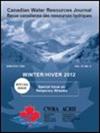Climate change impacts on snow and streamflow drought regimes in four ecoregions of British Columbia
IF 0.9
4区 环境科学与生态学
Q3 WATER RESOURCES
引用次数: 9
Abstract
Abstract In many regions with seasonal snow cover, summer streamflow is primarily sustained by groundwater that is recharged during the snowmelt period. Therefore, below-normal snowpack (snow drought) may lead to below-normal summer streamflow (streamflow drought). Summer streamflow is important for supplying human needs and sustaining ecosystems. Climate change impacts on snow have been widely studied, but the relationship between snow drought and streamflow drought is not well understood. In this study, a combined investigation of climate change impacts on snow drought and streamflow drought was completed using generic groundwater – surface water models for four headwater catchments in different ecoregions of British Columbia. Results show that, in response to increased precipitation and temperature, the snow drought regime changes substantially for all four catchments. Warm snow droughts, which are caused by above-normal winter temperatures, increase in frequency, and dry snow droughts, which are caused by below-normal winter precipitation, decrease in frequency. The shift toward more frequent and severe temperature-related snow droughts leads to decreased summer streamflow, decreased summer groundwater storage, and longer, more severe summer low flow periods. Moreover, snow droughts propagate into summer streamflow droughts more frequently in the future time periods (2050s, 2080s) as compared to the baseline 1980s period. Thus, warm snow droughts not only become more frequent and severe in the future but also more likely to result in summer streamflow drought conditions.气候变化对不列颠哥伦比亚省四个生态区的雪和流干旱状况的影响
在许多有季节性积雪的地区,夏季径流主要由地下水维持,在融雪期补给地下水。因此,低于正常的积雪量(雪旱)可能导致低于正常的夏季流量(流旱)。夏季水流对于满足人类需求和维持生态系统至关重要。气候变化对雪的影响已被广泛研究,但雪旱与河流干旱之间的关系尚不清楚。本文采用通用地下水-地表水模型,对不列颠哥伦比亚省不同生态区的4个水源集水区进行了气候变化对雪旱和径流干旱的影响研究。结果表明,随着降水和温度的增加,四个流域的雪旱状况发生了显著变化。暖雪干旱是由于冬季气温高于正常值导致的,频率增加;干雪干旱是由于冬季降水低于正常值导致的,频率减少。向更频繁和严重的与温度有关的雪干旱的转变导致夏季流量减少,夏季地下水储存量减少,夏季低流量期更长,更严重。此外,与20世纪80年代的基准期相比,雪旱在未来时间段(2050年代、2080年代)更频繁地演变为夏季径流干旱。因此,暖雪干旱不仅在未来变得更加频繁和严重,而且更有可能导致夏季河流干旱。
本文章由计算机程序翻译,如有差异,请以英文原文为准。
求助全文
约1分钟内获得全文
求助全文
来源期刊

Canadian Water Resources Journal
WATER RESOURCES-
CiteScore
2.90
自引率
5.90%
发文量
17
审稿时长
>12 weeks
期刊介绍:
The Canadian Water Resources Journal accepts manuscripts in English or French and publishes abstracts in both official languages. Preference is given to manuscripts focusing on science and policy aspects of Canadian water management. Specifically, manuscripts should stimulate public awareness and understanding of Canada''s water resources, encourage recognition of the high priority of water as a resource, and provide new or increased knowledge on some aspect of Canada''s water.
The Canadian Water Resources Journal was first published in the fall of 1976 and it has grown in stature to be recognized as a quality and important publication in the water resources field.
 求助内容:
求助内容: 应助结果提醒方式:
应助结果提醒方式:


